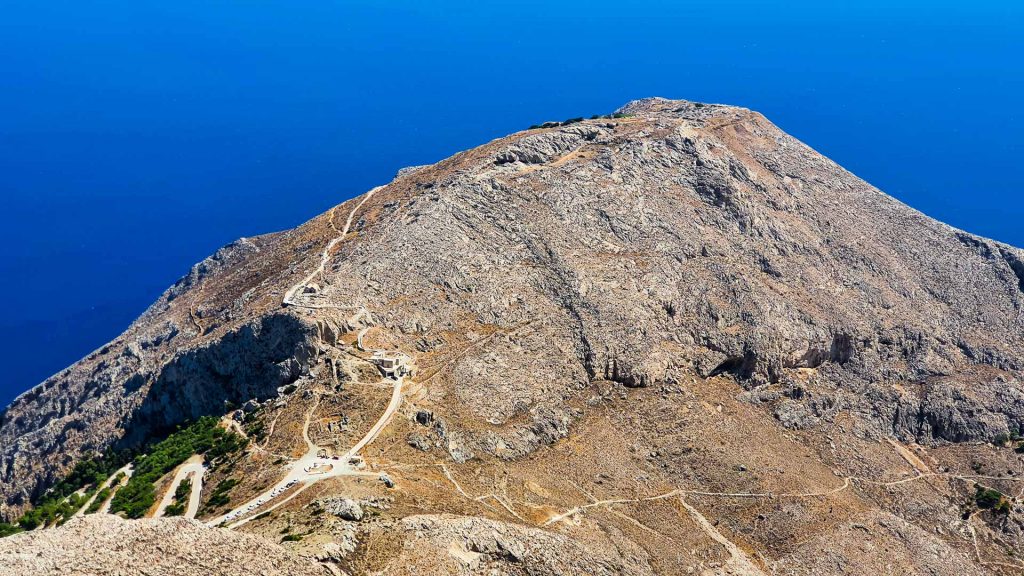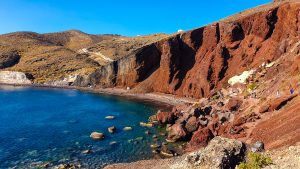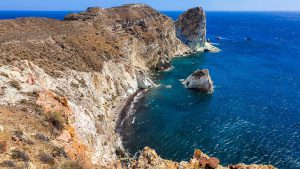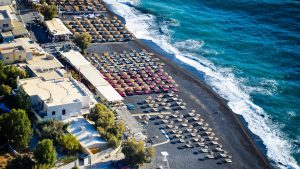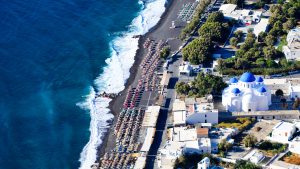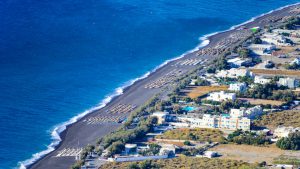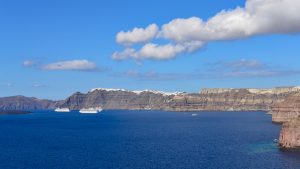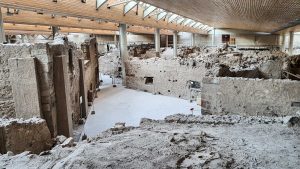Ancient Thera in Santorini was an ancient city that was located in the south-eastern part of the island on a rocky mountain called Mesa Vouno, over 360 meters above sea level. Currently, this place is adjacent to two very popular towns on the opposite sides of the mountain – Kamari and Perissa.
The ancient Thera is an unquestionable “must see” during your stay on Santorini. Here you can learn about the world of the ancient Greeks who lived on the island, deepen your knowledge of ancient history and culture, and enjoy beautiful panoramic views of the Aegean Sea and the island of Anafi looming in the distance.
A history of discovery
In 1895, the German archaeologist, Friedrich Hiller von Gaertringen, began excavations in the city, which were systematically carried out until 1904. This resulted in the discovery of a residential area and some cemeteries. Another discovery took place in the years 1961-1982, when N. Zapheiropoulos was working under the patronage of the Archaeological Society in Athens. It was then that the excavation of the necropolis of Sellada, a mountain saddle between the hills of Profitis Ilias and Mesa Vouno, was excavated. Finds of these works can be seen in the archaeological museum in Fira.
Subsequent excavations were carried out under the direction of Wolfram Hoepfner from Freie Universität Berlin in 1990-1994. Thanks to these discoveries, the history of the southern Aegean Sea could be better understood.
Founding of Thera
The history of ancient Thera dates back to the 9th-8th centuries BC. The city was founded by Doric colonists from Sparta. The place was chosen because of its strategic location. Namely, apart from the fact that Thera is located on a rocky mountain, it connects via a ridge called Sellada to the highest peak of Santorini, Profitis Ilias. Additionally, the slopes of Mesa Vouno joined the ports of Oia to the north (now Kamari) and Elefsina to the south (now Perissa). Thanks to this, it was not necessary to build defensive walls. The city also had access to the sea, and thus could conduct free trade.
Development
The most important stage in the history of the city began in the 4th century BC. At that time, the Macedonian Ptolemaic dynasty, ruling in Egypt, conquered Thera. The city began to serve as a naval base. As a result, soldiers appeared in it. Initially, it was three officers and about 300 soldiers, and over time this number increased. It was then that the expansion of the city began. Many temples were built in honor of Egyptian deities, public buildings, and peristyle houses. Also in the 1st century BC, when the island became part of the Roman province of Asia, many buildings were modernized, and public baths, characteristic of the Roman Empire, were built. Although Thera was not a large city and was located on the outskirts, it was of great importance at that time, as evidenced by the wealth of the town and the fact that its representatives gained high official positions.
Fall of Ancient Thera
However, around the 3rd century AD with the fall of the Roman Empire, the importance of Thera began to diminish. Moreover, some point out that the inhabitants began to move to where the terrain was more favourable. In Byzantine times, it was sometimes mentioned in documents as a diocesan city. Until the 5th century it was the only urban settlement on the island. The chronicler Theophanes mentions that in 726, there was a volcanic eruption, which was not particularly large, but which caused the city to be covered with a layer of pumice and, as a result, soon abandoned by the inhabitants.
Life and culture of ancient Thera
Over the course of more than a thousand years of history, many changes have taken place there. This was the result of a common phenomenon of evolving customs, culture and other factors. Ancient Thera was under the sovereignty of various countries and different peoples came there. In addition, there was a port there and trade facilitated contact with overseas places. These factors led to changes in the organisation of the city, its appearance, the customs of its inhabitants, culture and crafts. Thus the final shape of the city, which has been reconstructed by archaeologists, was the result of many factors from different times.
Ancient Thera Architecture
In the middle of Ancient Thera ran a road about 800 m long and 2 – 4 m wide, from which narrow streets ran perpendicularly, sometimes being dead ends.
The most important buildings in the city were:
Agora
It was located in the centre of the town. It was a rectangular square 110 m long and between 17 and 30 m wide. It was extended both under the Ptolemies and the Romans. It was the main place of gatherings as well as a place of worship. Around it there were public buildings and houses.
Basilike Stoa
It was a colonnaded building of Doric architectural order. It measured 46×10 m and its construction dates back to the beginning of the 3rd century BC. It was used for official and administrative matters. On one of the walls there were plaques saying that a citizen of Thera pledged to pay for the renovation of the building. On the other wall there was information about a resolution of the assembly of citizens and the council in honour of that citizen. The building was an ornament of the town, as it was crowned with a sculptural decoration. There were also monuments to Caesar and his family.
Theatre
Theatre was a very important place for the ancient Greeks. Performing plays was, among other things, part of the festivals in honour of Dionysus. The theatre in Thera was located near the Agora. It was built in the second century BC. It could accommodate as many as 1500 people, which was more than the population of the city. It was also used as a council meeting place (or buleuterion). In the 1st century AD. the theatre was adapted to the Roman style.
The Ephebe Gymnasium
The building was a gymnasium for ephebes, or young men aged 18 to 20, who were undergoing compulsory military training before becoming full citizens.
Temples
There were many temples in Thera, both Greek, Egyptian and Christian. They came from different times. It was possible to identify the following places of worship, among others:
- The temple of Apollo Karneios – probably built in the 7th century BC. It was one of the most important temples, because the cult of Apollo was dominant here throughout antiquity.
- The Temple of Artemidoros was founded by the priest Artemidoros who, following a dream vision, settled in Thera and created a temple in a natural cave. On its walls we can find well-preserved reliefs depicting, among others, a lion and an eagle.
- The temple of Egyptian deities – dates from the III century BC. Then the cult of three Egyptian deities – Serapis, Isis and Anubis – was introduced. It was initiated by the presence of Egyptians in the army.
- The Church of Agios Stefanos – or rather the Chapel of St Stephen, which was built on the ruins of an early Christian basilica, whose construction dates back to the middle of the 6th century.
In addition, there were also temples of Hera, Aphordite, Dionysus, Apollo Pythios and other buildings such as the residence of the Ptolemies, the commandant’s house, the house of Tyche and the soldiers’ barracks. Of course, today only the remains of ancient buildings from Hellenistic and Roman times can be seen, with plaques describing the individual ruins.
During the excavation works archaeologists also managed to find:
- sculptures,
- grave statues
- clay figures,
- ceramics (vases, pots) created in a geometric and oriental style, clearly influenced by the style originating on the island of Naxos,
- 3 kouros, that is statues representing young men, two of them from the 7th century BC and the last one, known as Apollo of Thera from the 6th century BC.,
- inscriptions from the time when the town was founded.
The found artefacts are now housed in the Prehistoric Museum in Fira, and Apollo’s kouros can be seen in the National Archaeological Museum in Athens.
History of public access
For a long time the excavations remained abandoned. It was not until the XXI Ephorate of Prehistoric and Classical Antiquities that the project “Configuration and establishment of the archaeological site of ancient Thera” was created. It was included in the Peripheral Corporate Programme South Aegean 2000-2006 and co-financed by the European Union. Thanks to the project, it was possible to achieve the objectives of conservation and protection of monuments and the arrangement and organisation of the archaeological site, as well as securing the infrastructural base.
Practical information
Opening hours of the archaeological site:
Winter:
(November to March)
Wednesday – Mondays 08:30 – 15:30
Summer:
(April to October)
Thursday – Tuesday
08:30 – 15:30
Closed on Wednesdays
The price of a full ticket is 6 euros, while a reduced ticket costs 3 euros.
It is also possible to buy a special package – a three-day ticket, which allows you to visit the archaeological site of ancient Thera, the archaeological site of Akrotiri and the Museum of Prehistoric Thera. Its price is 15 Euro (it is not possible to buy a combined discounted ticket).
It is also worth noting that, for example, on national holidays or days associated with cultural heritage, admission is free. These include:
- March 6
- April 18
- May 18
- the last weekend of September
- October 28
the first Sundays of each month from the beginning of November to the end of March
How to get to ancient Thera?
A winding road leads to the Ancient Thera from the seaside village of Kamari. It is accessible by car from 7:30 a.m. to 5:30 p.m. Pedestrian traffic is prohibited during these hours. The latter can only use it after 5:30 pm.
We encourage you to go for a walk to Ancient Thera along one of the picturesque routes:
- trail leading from Kamari, past Zoodochos Pigi and the ancient tombs of Sellada.
- trail leading from Perissa, past the church of Panagia Katefiani.
Interesting facts
- Ancient Thera contributed to the establishment of another village, located in Libya. According to Herodotus, a seven-year drought around 630 BC caused the inhabitants of Thera to send colonists to Cyranicea in present-day Libya. The settlement prospered and Thera became known as the mother city.
- Ancient Thera is undoubtedly a very interesting place. It has an intriguing history, including its name, supposedly derived from the mythical Spartan chief Theras, who colonised the place. Moreover, the official name of the island of Santorini is Thera.
Another curiosity is the finding of interesting rocks, such as andesite and scoria, in the Sarcient Thera area. Naturally, they do not occur at this site, but at least a few kilometres away. They were probably brought by the Spartans during the construction of the city. Although it has not been fully explained why these rocks were used and what their exact application was, the determination and perseverance of the Spartans, who brought heavy rocks from such a long distance to a high mountain, is admirable.


